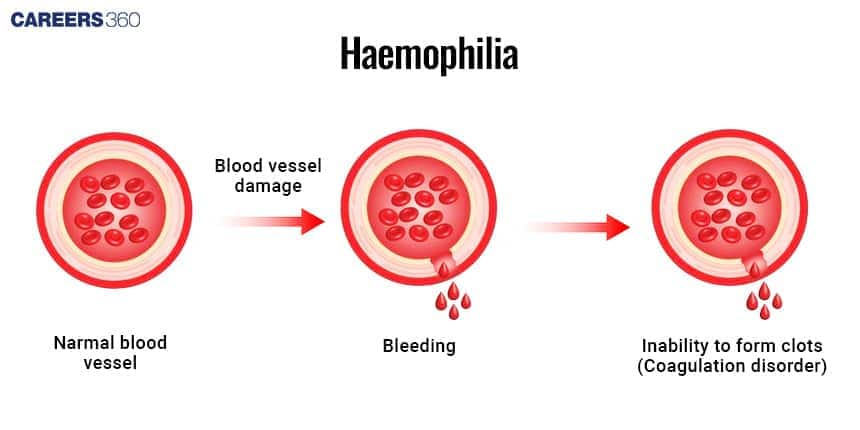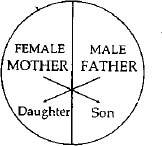Hemophilia: Overview, Meaning, Causes, types, symptoms, treatment
According to the World Health Organization (WHO), Haemophilia is an inherited bleeding disorder caused by a deficiency or abnormality of one of the clotting factors in the blood. It leads to prolonged or spontaneous bleeding. Haemophilia is a Human Genetic Disorder that affects blood clotting. It is caused by a type of mutation in the F8 or F9 gene on the X Chromosome.
This Story also Contains
- Definition Of Haemophilia
- Diagrammatic Representation of Haemophilia
- Types of Haemophilia
- Haemophilia Genetic Basis
- Symptoms And Diagnosis Of Haemophilia
- Diagnostic Methods
- The Video Recommended On Haemophilia:
- MCQs on Haemophilia

It is a classic example of a Mendelian disorder linked to the X chromosome, leading to prolonged bleeding. It involves the dysfunction of specific clotting factors—mainly Factor VIII or Factor IX. It can be studied using Pedigree Analysis to track its inheritance. Haemophilia is treated using recombinant DNA technology to make clotting factors.
Definition Of Haemophilia
Haemophilia is one of the rare genetic bleeding disorders involving the deficiency of certain clotting factors in the blood. It is responsible for proper blood coagulation; this causes spontaneous or post-injury prolonged bleeding due to the inability of blood to form clots as it should. It is linked to gene interaction when combined with other inherited traits.
The term "haemophilia" was first introduced in the 19th century, but the disorder was known as early as the 2nd century AD. The most famous royal families in Europe, direct descendants of Queen Victoria, have been recorded as suffering from hemophilia and have brought great awareness to the condition.
In the past, there was no treatment for haemophilia. The introduction of blood transfusions early in the 20th century was the first breakthrough. The introduction of factor concentrates during the 1960s–1970s changed the position greatly, making it possible for haemophilia patients to manage their illnesses more satisfactorily. Some of the recent developments are recombinant DNA technology and gene therapy—newly opened perspectives for treatment.
Diagrammatic Representation of Haemophilia
When there is blood vessel damage, bleeding starts. In haemophilia, due to a lack of clotting factors, the blood cannot form clots, leading to continuous bleeding—a condition called a blood coagulation disorder.

Types of Haemophilia
Based on which clotting factor is missing, haemophilia is divided into different types. Each type varies in frequency, severity, and inheritance pattern. Haemophilia is categorised as:
Haemophilia A (Factor VIII Deficiency)
This is the most frequent of the two, accounting for about 80% of the cases. It is caused due to the deficiency of factor VIII, which is a protein needed in blood clotting.
Haemophilia B (Factor IX Deficiency)
Haemophilia B, or Christmas disease, is due to a Factor IX deficiency. It is much rarer than Haemophilia A, but the clinical features are similar.
Rare Forms (e.g. Haemophilia C)
Haemophilia C is due to a Factor XI deficiency. It is extremely rare and usually only causes mild symptoms. It doesn't have the same X-linked recessive pattern of inheritance as Haemophilia A and B.
Haemophilia Genetic Basis
Haemophilia follows the principle of inheritance and variation because it is passed from parents to children with changes in the gene. It follows a specific X-linked recessive pattern. The details are given below:
Inheritance Patterns (X-linked Recessive)
Haemophilia A and B are inherited as X-linked recessive. The defective gene is located on the X chromosome. As males have one X chromosome, they are more commonly affected, whereas females, who have two X chromosomes, are typically carriers but may occasionally have milder expressions.
Genetic Mutations Involved
These conditions are due to a wide range of molecular bases of mutations in the F8 gene, which encodes for Haemophilia A, and the F9 gene, which encodes for Haemophilia B. They involve deletions, insertions, and even point mutations that affect the synthesis or functionality of these clotting factors.
Epidemiology
Haemophilia is rare, occurring in approximately 1 in every 5,000 male births for haemophilia A and 1 in every 30,000 male births for haemophilia B. The prevalence varies between regions depending on genetic factors and healthcare facilities.
Haemophilia occurs across all ethnic and geographic groups, often linked to family history. It is commonly diagnosed in infancy, although milder forms might be detected later in life.
Symptoms And Diagnosis Of Haemophilia
Haemophilia is mainly identified by its bleeding symptoms due to the lack of clotting factors. The severity of symptoms varies depending on how much clotting factor is present in the blood. The symptoms and diagnosis are described below:
Common Signs And Symptoms
People suffering from haemophilia often bleed for a longer period. They have frequent nosebleeds, easy bruising of skin and muscles, and excessive bleeding after being injured or operated on. Some of the major challenges most of these patients go through include pain and swelling of joints due to internal bleeding (haemarthrosis).
Mild Haemophilia: With 5-40% of normal clotting factor levels; usually, they bleed only after surgery or trauma.
Moderate Haemophilia:1-5% of normal clotting factor levels; bleeding at times occurs after minor injuries.
Severe Haemophilia: <1% of normal clotting factor levels; spontaneous bleeding episodes are frequent.
Diagnostic Methods
Haemophilia is diagnosed to check for bleeding problems and to start treatment early. The main methods include blood tests, genetic testing, and checking the family history.The diagnostic methods are described below:
Blood Tests (Factor VIII and IX Levels)
Diagnosis is primarily by blood tests measuring Factor VIII or IX levels. Low levels of these factors confirm the diagnosis of Haemophilia A or B.
Genetic Testing
Genetic testing may show specific mutations in the F8 or F9 genes, which can help in confirming the diagnosis and explaining the genetic basis of the disorder. This might help in family planning or to identify carriers.
Family History Analysis
A good family history of haemophilia can indicate the pattern of inheritance and the risk to family members. Genetic counselling is usually indicated in families with a family history of this condition.
The Video Recommended On Haemophilia:
MCQs on Haemophilia
Question: In the following questions, a statement of assertion (A) is followed by a statement of reason (R)
(1) If both Assertion & Reason are true and the reason is the correct explanation of the assertion, then mark A
(2) If both Assertion & Reason are true but the reason is not the correct explanation of the assertion, then mark B
(3) If the Assertion is a true statement but the Reason is false, then mark C
(4) If both Assertion and Reason are false statements, then mark D
Assertion: In rare cases, a person can develop hemophilia later in life. The majority of cases involve middle-aged or elderly people, or young women who have recently given birth or are in the later stages of pregnancy.
Reason: Hemophilia is caused by a mutation or change, in one of the genes, that provides instructions for making the clotting factor proteins needed to form a blood clot.
A
B
C
D
Answer: Both Assertion & Reason are true but the reason is not the correct explanation of the assertion.
The severity of haemophilia that a person has is determined by the number of factors in the blood. The lower the amount of the factor, the more likely it is that bleeding will occur which can lead to serious health problems.
In rare cases, a person can develop haemophilia later in life. The majority of cases involve middle-aged or elderly people, or young women who have recently given birth or are in the later stages of pregnancy. This condition often resolves with appropriate treatment.
Hence, the correct answer is option 2) B
Question: It is well known that Queen Victoria of England was a carrier for haemophilia. Since this is an X-linked disease, it can be predicated that
All of her sons would have had disease
All her daughters would have been carriers
Her father must definitely have had haemophilia
Haemophilia would have occurred in more of her male than her female descendants
Answer: Cause of Haemophilia - A single protein that is a part of the cascade of a protein involved in the clotting of blood is affected. The heterozygous female (carrier) for haemophilia may transmit the disease to sons. Eg: The family pedigree of Queen Victoria shows the number of haemophilia decedents and she was the carrier.
Hence, the correct answer is option 4) Haemophilia would have occurred in more of her male than her female descendants.
Question: Represented below is the inheritance pattern of certain type of traits in humans. Which one of the following conditions could be an example of this pattern?

Sickle cell anaemia
Haemophilia
Thalassemia
Phenylketonuria
Answer: Haemophilia is a sex-linked recessive condition that affects the male sex and is inherited by some of the male offspring from apparently normal female carriers. It results when there is an alteration in the genes that encode clotting factors VIII or IX on the X chromosome. The main problem with haemophilia is severe bleeding because slight cuts can easily cause haemorrhage due to the failure of blood coagulation. Carrier females are usually asymptomatic but may present with mild symptoms, whereas affected males suffer from severe manifestations.
Hence, the correct answer is Option (2) Haemophilia.
Also Read:
Frequently Asked Questions (FAQs)
Blood tests for clotting factors VIII and IX will tell their levels, while genetic testing can also be done to confirm the specific mutations involved.
It has treatment options such as prophylactic and on-demand factor replacement therapy, gene therapy, and more recent ones like monoclonal antibodies. Some changes in lifestyle and management of the bleeding episode are equally important.
Haemophilia is a genetic disorder whereby the inability of blood to clot is caused by a deficiency in clotting factors. The pattern of inheritance is on the X chromosome; thus, the majority of cases are found in males, with females only being carriers.
The major types include Haemophilia A, caused by a Factor VIII deficiency, and another is Haemophilia B, caused by a Factor IX deficiency. Then there is also an uncommon form called Haemophilia C, due to a Factor XI deficiency.
The common symptoms that are usually visible include long bleeding, frequent nosebleeds, easy bruising, excessive bleeding after injuries, and pain and swelling in the joints due to internal bleeding.